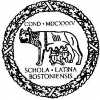 Known by Armenians as the Great Calamity, the Armenian Genocide refers to the deliberate and systematic destruction of the Ottoman Empire’s Armenian population during and after World War I. Characterized by the use of massacres and forced marches designed to lead to the death of deportees, the genocide is estimated to have claimed up to 1 million Armenian lives. The onset of the genocide is generally accepted to be April 24, 1915, the day that Ottoman authorities did what? Discuss
Known by Armenians as the Great Calamity, the Armenian Genocide refers to the deliberate and systematic destruction of the Ottoman Empire’s Armenian population during and after World War I. Characterized by the use of massacres and forced marches designed to lead to the death of deportees, the genocide is estimated to have claimed up to 1 million Armenian lives. The onset of the genocide is generally accepted to be April 24, 1915, the day that Ottoman authorities did what? Discuss
Source: The Free Dictionary

 De Kooning was a Dutch-American painter who became a leader of abstract expressionism, the New York-based school of painting that rejected naturalistic content. Examples of this period include his dramatic Black Paintings, which were black-and-white artworks created from enamel and oil paints. His later work became increasingly figurative, as is seen in his The Woman series of the 1950s, and was both criticized and lauded. In what unusual way did de Kooning immigrate to the US?
De Kooning was a Dutch-American painter who became a leader of abstract expressionism, the New York-based school of painting that rejected naturalistic content. Examples of this period include his dramatic Black Paintings, which were black-and-white artworks created from enamel and oil paints. His later work became increasingly figurative, as is seen in his The Woman series of the 1950s, and was both criticized and lauded. In what unusual way did de Kooning immigrate to the US?  Gotham City is a fictional city that is best known as the home of DC Comics’ Batman character. Gotham is known to be architecturally modeled after New York City, but with exaggerated elements and styles. Gotham also sometimes serves as a nickname for New York, and was first popularized as such by the author Washington Irving. What is Arkham Asylum?
Gotham City is a fictional city that is best known as the home of DC Comics’ Batman character. Gotham is known to be architecturally modeled after New York City, but with exaggerated elements and styles. Gotham also sometimes serves as a nickname for New York, and was first popularized as such by the author Washington Irving. What is Arkham Asylum?  The Boston Latin School in Massachusetts, originally a school for boys that had just a handful of students, is now a coeducational institution serving more than 2,000 youngsters. It has the distinction of being the oldest public school in the US and claims many influential Bostonians as alumni, including four Harvard University presidents, four Massachusetts governors, and five signers of the Declaration of Independence. Who are the school’s most famous dropouts?
The Boston Latin School in Massachusetts, originally a school for boys that had just a handful of students, is now a coeducational institution serving more than 2,000 youngsters. It has the distinction of being the oldest public school in the US and claims many influential Bostonians as alumni, including four Harvard University presidents, four Massachusetts governors, and five signers of the Declaration of Independence. Who are the school’s most famous dropouts?  No one really knows the exact date of
No one really knows the exact date of  Roy Orbison was an influential American singer-songwriter and rock-and-roll pioneer whose career spanned more than three decades. He had a string of hits during the early-1960s, such as “Only the Lonely” and “Oh, Pretty Woman,” after which his career waned, driven in part by a series of personal tragedies. He made a comeback in the 1980s, forming a supergroup with Bob Dylan, George Harrison, and Tom Petty called the Traveling Wilburys. What was Orbison rarely seen in public without?
Roy Orbison was an influential American singer-songwriter and rock-and-roll pioneer whose career spanned more than three decades. He had a string of hits during the early-1960s, such as “Only the Lonely” and “Oh, Pretty Woman,” after which his career waned, driven in part by a series of personal tragedies. He made a comeback in the 1980s, forming a supergroup with Bob Dylan, George Harrison, and Tom Petty called the Traveling Wilburys. What was Orbison rarely seen in public without?  Chameleons have laterally flattened bodies and bulging, independently rotating eyes. They are variously ornamented with crests, horns, and spines. They feed chiefly on insects and are unique among lizards in possessing long, sticky tongues with which they capture their prey. Their changes in skin color are under hormonal and nervous control and are not affected by the color of the background but by stimuli such as light, temperature, and emotion. “Chameleon” is derived from what Greek words?
Chameleons have laterally flattened bodies and bulging, independently rotating eyes. They are variously ornamented with crests, horns, and spines. They feed chiefly on insects and are unique among lizards in possessing long, sticky tongues with which they capture their prey. Their changes in skin color are under hormonal and nervous control and are not affected by the color of the background but by stimuli such as light, temperature, and emotion. “Chameleon” is derived from what Greek words?